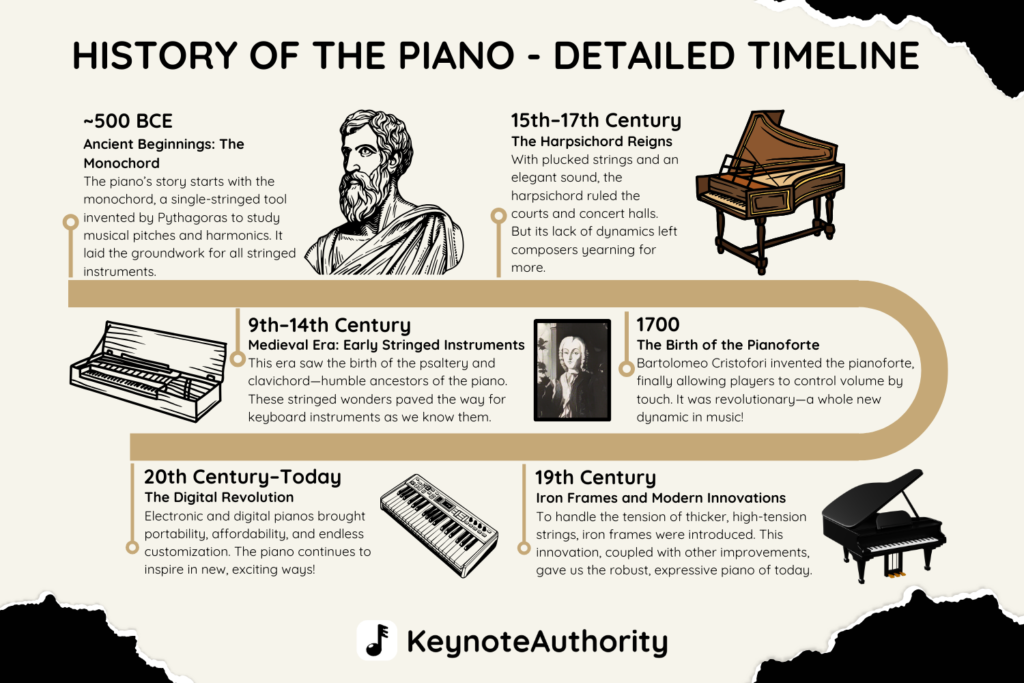
Who invented the piano, and how did it become the world’s most popular instrument? What makes the piano so unique compared to its predecessors? And how did it evolve into the grand pianos we see today?
These are just a few of the questions I’ll answer in this article!
From Mozart’s compositions to modern-day movie scores, the piano has charmed its way into nearly every corner of music history. But believe it or not, the piano as we know it is a relatively recent invention!
Its origins include plucked strings, evolving key mechanisms, and quite a few musical missteps along the way.
The piano is THE most played instrument in the world, and it has come a long way from its humble beginnings in Bartolomeo Cristofori’s workshop (not his garage! 😝).
From clavichords and harpsichords to the modern-day piano, we’ll discover the fascinating evolution of the “Pianoforte.”
Timeline – A Journey Through Time
500 BC:
Ancient Beginnings – The Monochord
To understand the piano’s origins, we need to go back to ancient Greece, around 500 BCE, where a simple yet ingenious instrument known as the monochord was first conceived. Think of it as the great-grandparent of the piano—a far cry from the 88-key marvels we know today, but an essential stepping stone.
The monochord was as straightforward as it sounds: a single string stretched taut over a hollow wooden box. A movable bridge divided the string into segments, changing the pitch and creating different tones. It wasn’t exactly designed for melodies or harmonies, but its purpose wasn’t performance—it was discovery.
Key Date: Around 500 BCE
Greek philosopher Pythagoras famously used the monochord to explore the relationship between string length and pitch. By plucking the string at different points and adjusting the bridge, he identified the mathematical ratios that underlie musical intervals like octaves and fifths. These insights didn’t just shape ancient Greek music; they laid the foundation for the Western tuning systems that we still use today.
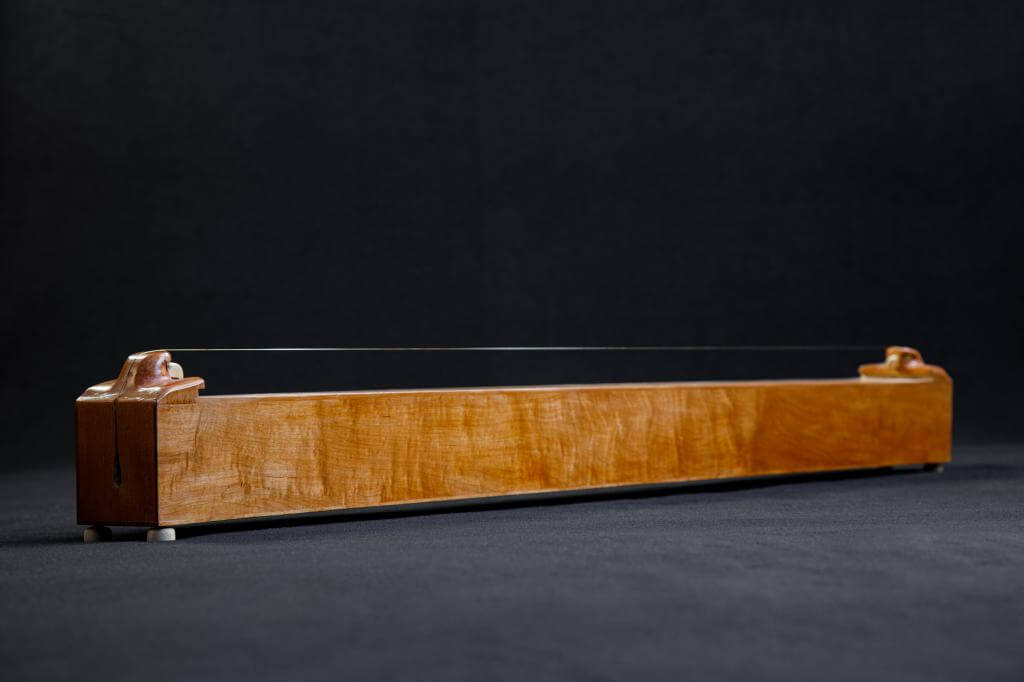
Monochord made by Unprofitable Instruments
😮 Fun Fact
The monochord wasn’t used for performances—it was more of a musical calculator for scholars. Imagine impressing your friends not with a Chopin etude but with the perfect ratio of a major third. 🤓
Why the Monochord Mattered
Though it couldn’t produce the rich soundscapes of a piano, the monochord was a scientific marvel. It demonstrated that music isn’t just an art—it’s also a mathematical phenomenon. This revelation paved the way for the development of stringed instruments, each building on the principles uncovered by Pythagoras.
Without the monochord, there would be no clavichord, harpsichord, or ultimately, the piano. It’s a reminder that even the simplest tools can spark revolutions in creativity and innovation.
The monochord may not have been much to listen to, but it proved something profound: that the sounds we hear are shaped by the laws of nature. From this humble beginning came the tuning systems, techniques, and craftsmanship that would eventually lead to the modern piano.
9th–14th Century:
Medieval Innovations – Early Stringed Instruments
As music evolved during the medieval period, so did the instruments that would eventually lead to the piano. The dulcimer and the clavichord emerged as pivotal innovations, offering distinct approaches to producing sound and setting the stage for future developments.
The dulcimer appeared in Europe during the 9th century, adapted from earlier Middle Eastern instruments like the Persian santur. With strings stretched over a flat soundboard, the dulcimer was played by striking its strings with lightweight mallets, creating a bright, percussive sound. Though it couldn’t offer dynamic range, its use of multiple strings to create polyphony marked a significant step forward in musical complexity.
But the real game-changer of the Middle Ages was the clavichord, which emerged in the 14th century. Unlike the dulcimer, the clavichord introduced a key mechanism that allowed players to control sound directly. Small metal tangents struck the strings, not only producing tones but also allowing subtle dynamic expression through varying finger pressure—a first for keyboard instruments.
Key Medieval Dates:
- 9th Century: The dulcimer gains popularity in Europe, becoming an important instrument in both folk and court music. Its striking mechanism foreshadows the hammer action of the piano.
- 14th Century: The clavichord begins to spread across Europe, particularly in Germany, as a practice instrument for musicians seeking greater control over dynamics and expression.
- 15th Century: Improvements to the clavichord make it quieter and more compact, ideal for private use in homes and monasteries.
😮 Fun Fact
The clavichord was so quiet that players could hold conversations while playing. Today’s pianists would probably call that multitasking!
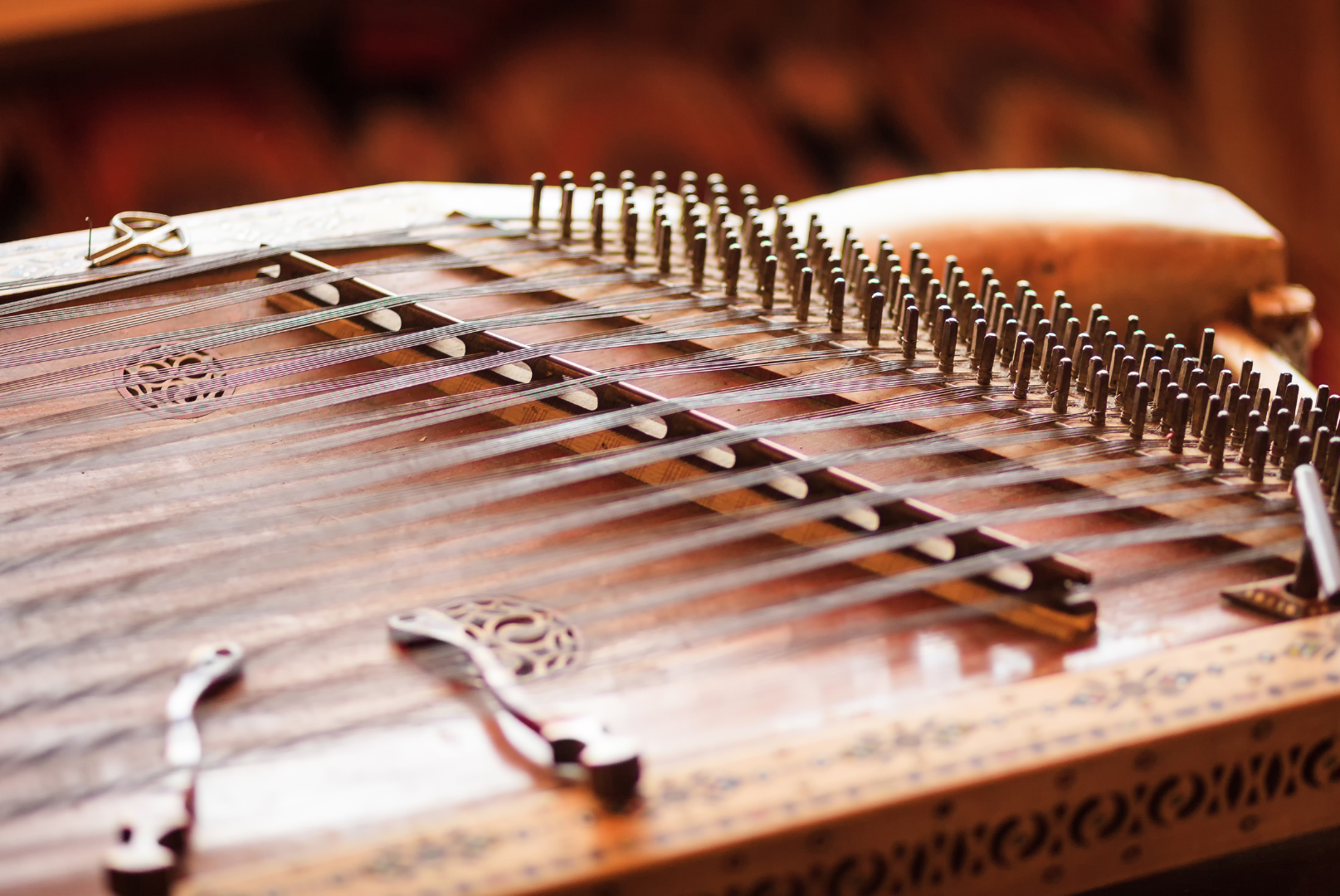
Dulcimer with a pair of hammers.
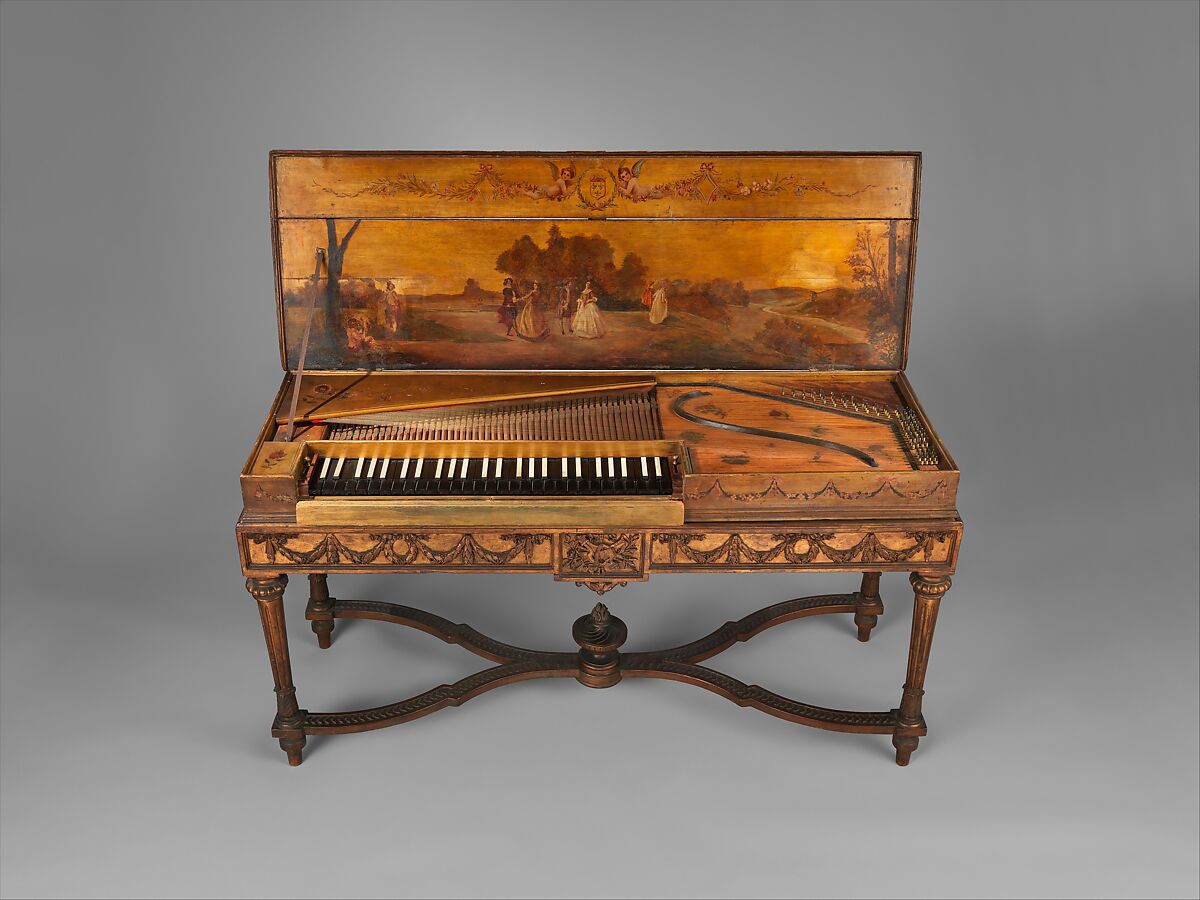
Clavichord dated around the 1700s
Listen to the sound of the Hammered Dulcimer
Listen to an audio sample of the Clavichord
How did the Dulcimer and Clavichord lead to the piano?
The dulcimer introduced the foundational concept of striking strings to produce sound, a principle later refined by the clavichord. Unlike the dulcimer, the clavichord added dynamic control, allowing players to vary the volume and expression of their music—though its range was limited to softer tones. This innovation marked a key evolution toward the piano’s hammer-action mechanism.
The clavichord also served as a quiet, personal instrument ideal for practice and experimentation. Its responsive touch enabled composers to explore melody and harmony in new ways, laying the groundwork for the expressive capabilities of future keyboard instruments.
Together, the dulcimer and clavichord represent milestones in the journey toward the piano. They bridged the gap between ancient instruments like the monochord and the sophisticated mechanisms that would eventually define the pianoforte.
15th–17th Century:
The Harpsichord’s Golden Age
Fast forward to the Renaissance, and you’ll encounter the harpsichord, the clavichord’s louder, fancier cousin. Unlike the clavichord, which struck strings to produce its gentle sound, the harpsichord used quills to pluck its strings. This gave it a bright, crisp tone that resonated through royal courts, cathedrals, and concert halls. Its ornate designs and powerful sound made it the centrepiece of European music, symbolizing both wealth and artistic sophistication.
Key Dates in Harpsichord History:
- Early 1400s: The first harpsichords appear in Italy. These early instruments were relatively simple but marked a major leap in volume and projection over the clavichord.
- 1520s–1530s: Harpsichords gain popularity across Europe, spreading to France, Spain, and the Low Countries. Builders begin experimenting with multiple string configurations to enhance sound quality.
- 1600s: The craftsmanship of the harpsichord peaks, with celebrated builders like the Ruckers family in Belgium producing some of the most beautiful and finely tuned instruments of the era.
- Mid-1600s: Harpsichords with two keyboards (or manuals) emerge. These allow musicians to switch between tones, creating a wider palette of sound. It’s akin to having a luxury vehicle with sport and cruise modes!
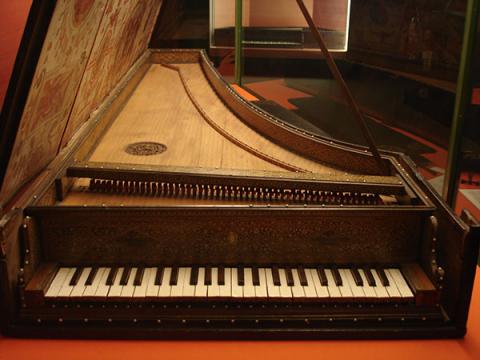
Italian harpsichord with one keyboard (17th century).
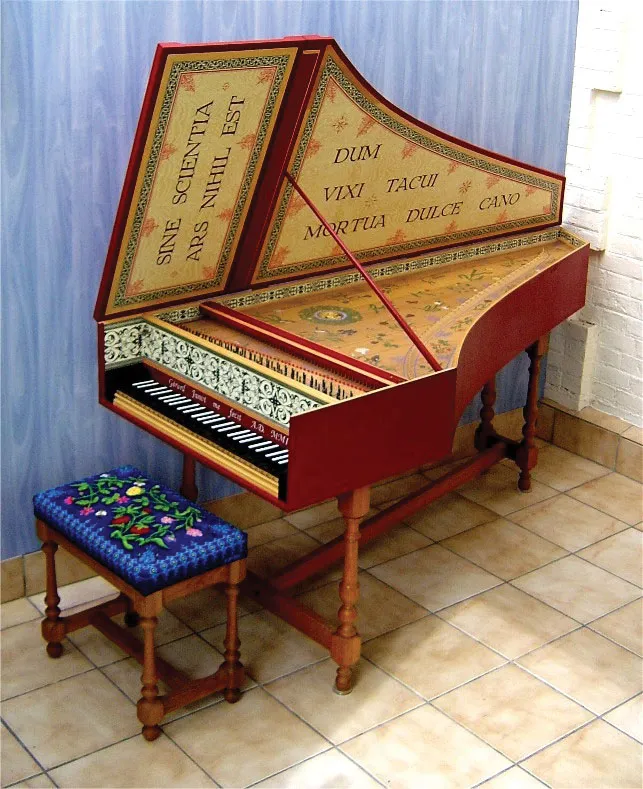
Flemish style harpsichord
Listen to a short audio clip of the harpsichord!
Despite its elegance and innovation, the harpsichord had one critical limitation: no dynamic control. Whether you tapped a key lightly or pounded it with passion, the volume stayed exactly the same. This lack of expressive range frustrated musicians, particularly as the demand for emotionally nuanced performances grew. Composers and players alike began longing for an instrument that could whisper, cry, or shout with equal ease—one that would allow the player’s emotions to flow seamlessly into the music.
1700s:
The Birth of the Pianoforte
Enter Bartolomeo Cristofori, a brilliant instrument maker from Florence, Italy, who dared to dream of something more expressive. In 1700, Cristofori unveiled the pianoforte, a revolutionary invention that used hammers instead of quills to strike the strings. He called it the “gravicembalo col piano e forte“, which means ‘harpsichord with soft and loud’ when translated to english. This simple but ingenious innovation allowed musicians to vary the instrument’s volume—from soft whispers to thunderous roars—giving them an unprecedented level of emotional control.
Key Dates in the Birth of the Piano:
- 1700: Cristofori builds the first pianoforte, a modest-looking instrument with a wooden frame, leather-covered hammers, and 40-50 keys. This prototype marked the beginning of a musical revolution.
- 1709: Cristofori continues refining his design, introducing features like an early form of the escapement mechanism, which allowed hammers to quickly disengage from the strings for smoother, repeated notes.
- 1720: A surviving Cristofori pianoforte from this year is preserved today at the Metropolitan Museum of Art in New York, offering a glimpse into his craftsmanship.
- 1726: The Giornale de’ Letterati d’Italia, an influential journal of the time, publishes a detailed description of Cristofori’s invention, spreading awareness of this groundbreaking instrument across Europe.
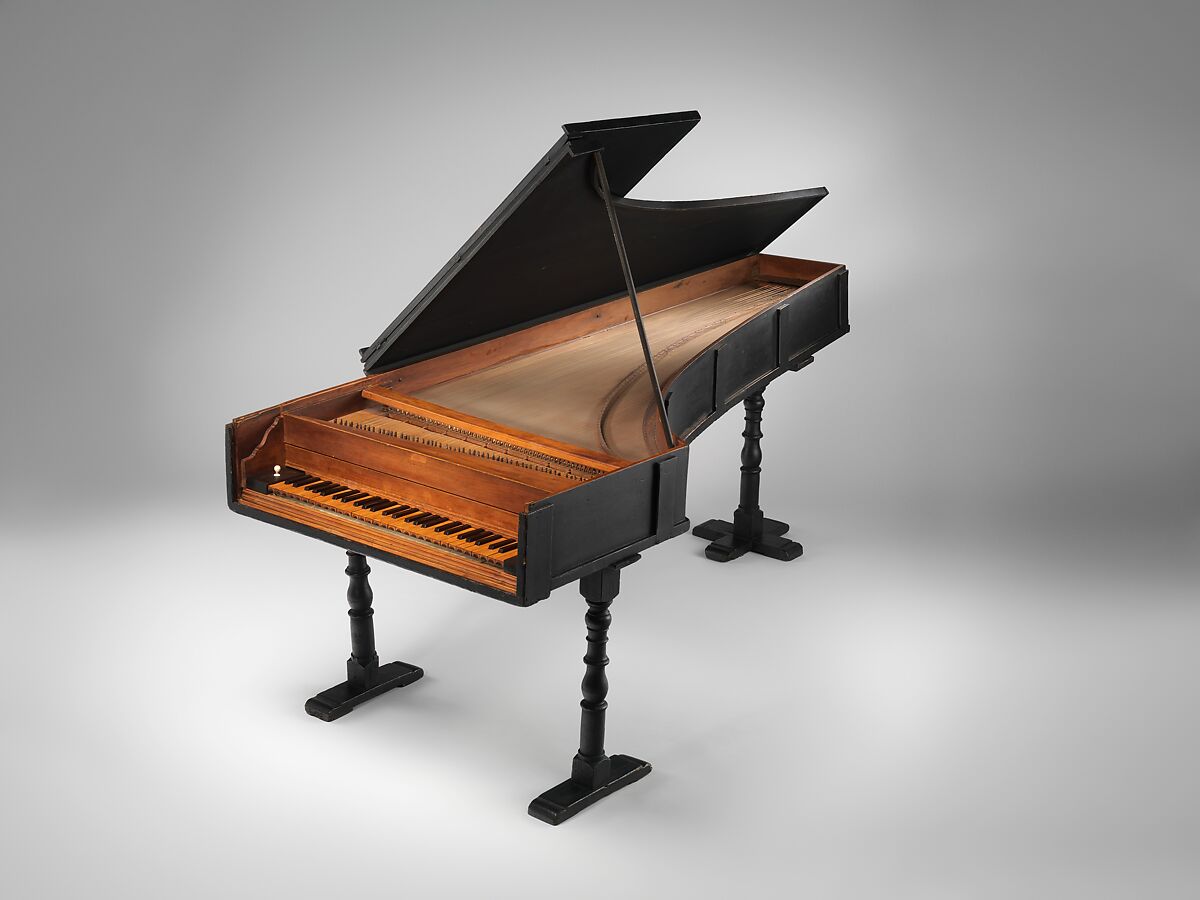
One of Cristofori’s original pianos, dated 1720
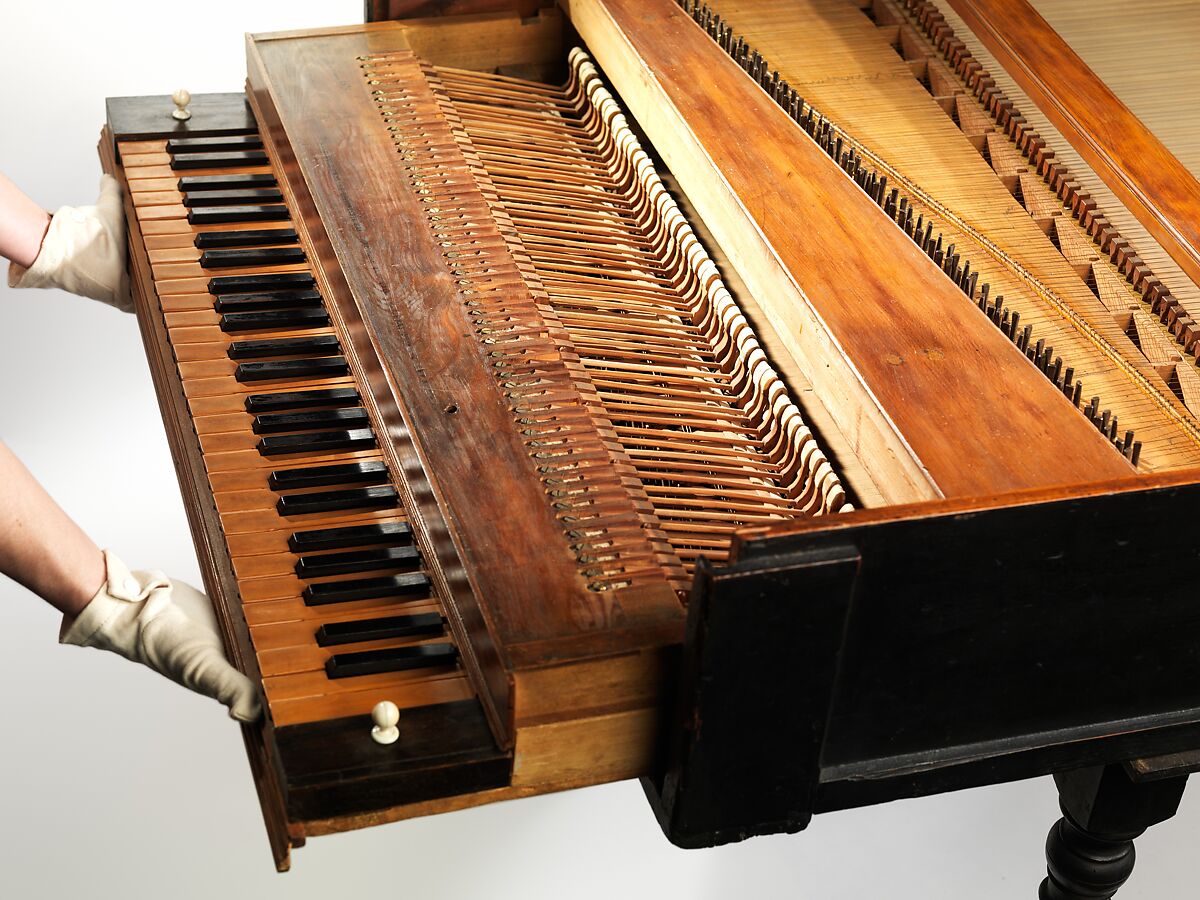
Cristofori’s 1720 piano, mechanism partly visible
Listen to a short audio sample of ‘Sonata K.9 by Domenico Scarlatti’ played on the original 1720 piano. (Full version here)
😮 Fun Fact
Early pianofortes had only 40-50 keys, compared to the 88 we use today. Imagine trying to play Beethoven’s “Moonlight Sonata” on that!
Why “Pianoforte”?
The name “pianoforte” comes from the Italian words for soft (piano) and loud (forte), perfectly encapsulating the instrument’s ability to produce a dynamic range of sounds. Unlike its predecessors, the pianoforte could reflect the full emotional palette of a piece, from delicate pianissimos to dramatic fortissimos.
Initially, the pianoforte was a niche instrument, largely reserved for the wealthy elite due to its cost and complexity. However, as composers like Haydn, Mozart, and Beethoven began exploring its expressive potential, its popularity soared. By the late 18th century, it was no longer just an aristocratic novelty—it was on its way to becoming the centerpiece of Western music.
19th Century:
Iron Frames and Piano Evolution
By the 19th century, the piano had become a symbol of musical expression and technical innovation, but it faced a major structural challenge: supporting the immense tension of its strings. With over 20 tons of pressure exerted on the frame, the traditional wooden construction was being pushed to its limits. In extreme cases, this tension could warp the frame or even cause strings to snap—a risk no performer wanted to face during a climactic moment.
The solution? The iron frame, a groundbreaking innovation that provided the durability and stability needed to handle thicker, high-tension strings. This advancement not only made the piano more reliable but also allowed it to produce richer, louder tones, perfectly suited for the growing size of concert halls in the Romantic era.
Beyond structural improvements, this century saw innovations in the piano’s mechanics that transformed how it was played. The damper pedal, for example, became a defining feature of the instrument, enabling pianists to sustain notes and create lush, resonant harmonies that captivated audiences.
Key Dates in Piano Engineering:
- 1820s: The first iron-framed pianos begin to appear, initially as partial supports to reinforce wooden structures. These early hybrids marked the transition to fully iron frames.
- 1859: Steinway & Sons patents the overstrung scale, a revolutionary design where bass strings overlap the treble strings at an angle. This innovation produces a fuller, richer sound and becomes a defining feature of modern pianos.
- 1870s: Fully cast-iron frames become standard in piano manufacturing, allowing for the immense string tension we associate with contemporary instruments.
- Late 19th Century: The modern pedal system is refined, with the damper pedal (sustain) and soft pedal (una corda) becoming standard. These mechanisms enable pianists to explore new levels of expression and dynamic contrast.
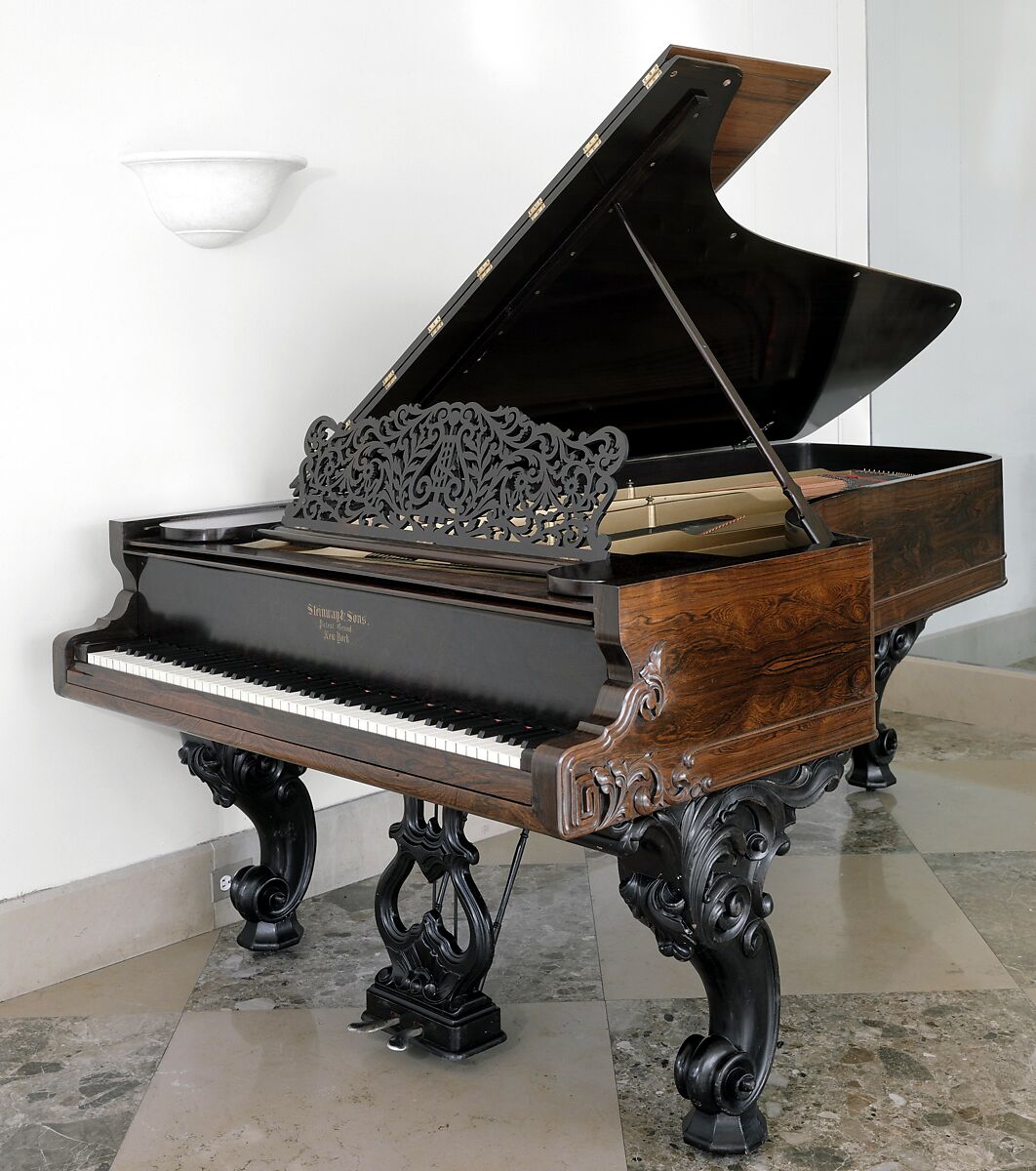
Steinway & Sons Grand Piano, Plain Grand Style 2, 1868
These advancements allowed the piano to fill concert halls with unprecedented power, capturing the Romantic spirit of the 19th century. Composers like Chopin, Liszt, and Debussy were inspired by the piano’s newfound capabilities, using its expanded tonal range and dynamic control to create masterpieces that still resonate today.
While the iron frame ensured durability, innovations like the damper pedal elevated the instrument’s expressive potential, making it the centerpiece of Western music and a symbol of both artistry and engineering.
20th Century to Today:
The Rise of Digital Pianos
The 20th century was a whirlwind of technological innovation, and the piano evolved right alongside it. As society embraced technology, pianos did too, transforming from purely acoustic marvels into electric and digital instruments that revolutionized how—and where—music could be played. From smoky jazz clubs to living rooms around the world, the piano became more portable, versatile, and accessible than ever before.
The rise of electric pianos like the Fender Rhodes in the 1940s and 50s offered musicians a new sonic palette, perfect for jazz, pop, and experimental genres. By the late 20th century, digital pianos like the Yamaha Clavinova raised the bar further, blending portability with increasingly realistic acoustic piano sounds.
Key Dates in the Modern Piano Era:
- 1935: The Neo-Bechstein, the world’s first electric piano, debuts. It uses electromagnetic pickups to amplify sound—paving the way for later legends like the Rhodes and Wurlitzer.
- 1946: Harold Rhodes introduces the Fender Rhodes piano, a game-changing electric instrument with a warm, bell-like tone. Its compact design makes it a staple in jazz and pop music.
- 1983: Yamaha launches the Clavinova series, revolutionizing digital pianos. These instruments offer realistic acoustic sounds, weighted keys, and features like MIDI connectivity, setting the standard for modern digital pianos.
- 2000s: Digital technology takes a leap with hybrid pianos, blending the physical mechanisms of acoustic pianos with advanced sound sampling for the ultimate playing experience.
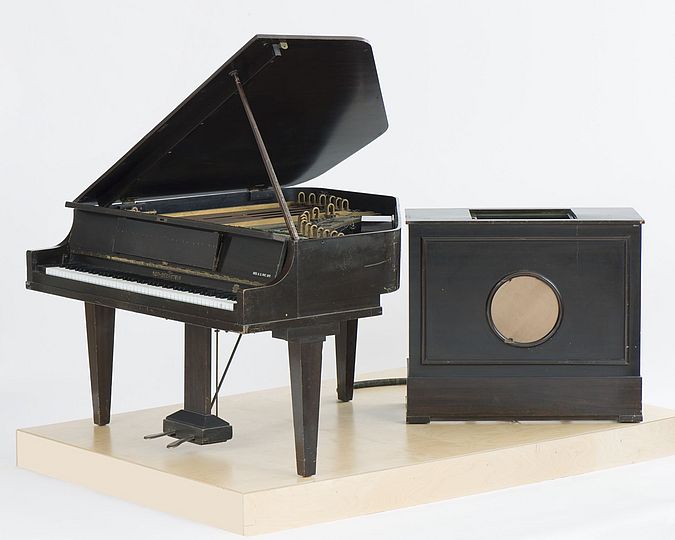
The World’s First electric piano, the neo-Bechstein, with its amplification system. Built around the 1930s primarily by Walther Nernst
Short audio clip of the neo-Bechstein
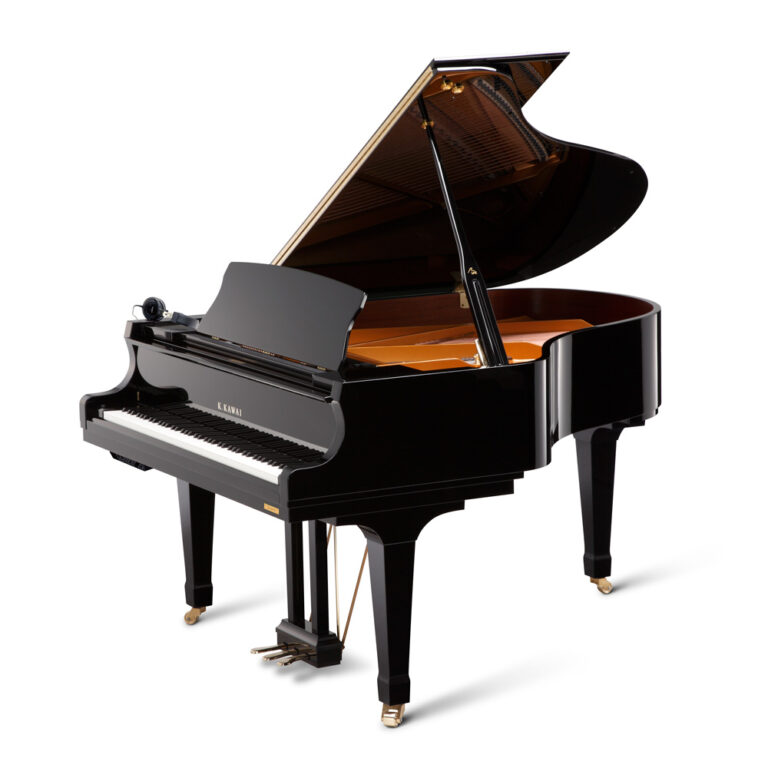
Kawai’s Flagship Hybrid piano, costing upwards of $55 000
Today, pianists enjoy a spectrum of choices that would have been unimaginable a century ago. Want a piano that fits in your studio apartment? A digital keyboard with authentic sounds and headphones is your best friend. Dreaming of playing a grand piano in a concert hall? The craftsmanship of acoustic pianos remains unparalleled for their tonal richness and expressive power.
😮 Fun Fact
Most of the piano keys have 3 strings each, though the lowest have just one or two.
While electric and digital pianos offer portability and innovation, the acoustic piano holds its place as the timeless soul of classical and contemporary music. Whether it’s the nostalgic hum of a Fender Rhodes, the precise sampling of a Yamaha Clavinova, or the resonance of a concert grand, the piano continues to inspire musicians and listeners alike.
Key Contributors to the Piano’s Evolution
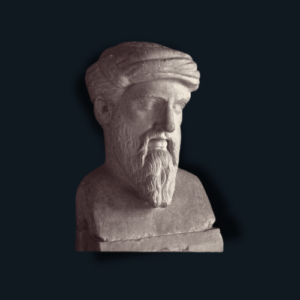
Pythagoras
(c. 570–495 BCE)
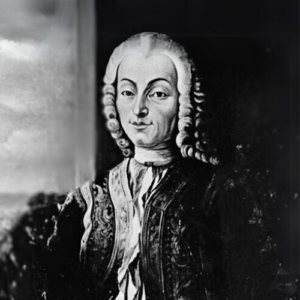
Bartolomeo Cristofori
(1655–1731)
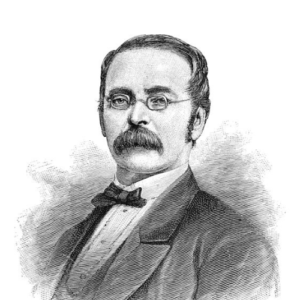
Henry E. Steinway
(1797–1871)
The piano’s story is nothing short of striking (pun intended). From the monochord’s single string in ancient Greece to the concert grand’s 88 keys of brilliance, every step has shaped the instrument we know and love today. Each innovation—the dynamic control of the clavichord, the projection of the harpsichord, and the expressive hammer action of the pianoforte—brought music closer to our hearts and hands.
The 19th century supercharged the piano’s evolution, with iron frames and modern pedals giving it the strength and versatility to fill grand concert halls. And let’s not forget the 20th century, where the piano plugged into the future, giving us electric and digital variations that expanded its reach and sound palette.
Whether it’s a quiet clavichord in a medieval study or a hybrid digital marvel in a city apartment, the piano has always adapted, proving that its legacy is as resilient as its iron frame.
Thanks for sticking with us through this incredible journey. We hope you’ve enjoyed reading as much as we’ve enjoyed sharing. Now, go on—strike a chord and make your own music history! 🎹

Thank you so much!!!